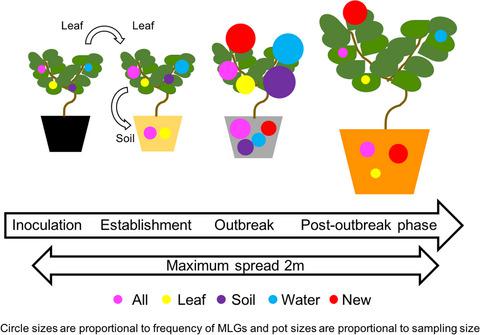当前位置:
X-MOL 学术
›
Plant Pathol.
›
论文详情
Our official English website, www.x-mol.net, welcomes your
feedback! (Note: you will need to create a separate account there.)
Epidemiology and microevolution of Phytophthora ramorum during a controlled disease outbreak in a simulated plant production facility
Plant Pathology ( IF 2.3 ) Pub Date : 2019-12-18 , DOI: 10.1111/ppa.13127 M. S. Serrano 1 , C. Eyre 1 , M. Garbelotto 1
Plant Pathology ( IF 2.3 ) Pub Date : 2019-12-18 , DOI: 10.1111/ppa.13127 M. S. Serrano 1 , C. Eyre 1 , M. Garbelotto 1
Affiliation

|
Phytophthora ramorum outbreaks have been documented to occur in natural settings during favourable environmental conditions, and to be caused by the overdominance of highly infectious genotypes. However, little is known about the dynamics of outbreaks in nursery settings. Through the description and quantification of symptoms, as well as through systematic pathogen isolation and genotyping, this study examines the scale and dynamic of spread of four different genotypes of P. ramorum in soil, water and leaves among Rhododendron plants in a nursery setting. Phytophthora ramorum isolation success was highest from leaves and intermediate from soil, reaching peak values at the end of the wet-warm season. The observed disease outbreak was of moderate intensity, and abundance among the four genotypes used as inoculum varied, depending on substrate and isolation time. The spread mechanism of the disease was mostly through leaf-to-leaf contagion, followed by leaf-to-soil, and the scale of pathogen spread was less than 2 m in the 20 months of the experiment. Surprisingly, a large number of novel genotypes were detected during the experiment, and all were clearly derived from the four used as inoculum. The frequency of two such novel genotypes in the postoutbreak phase was comparable to the frequency of some of the original four genotypes, suggesting they may be competitive. The creation of new genotypes in a nursery setting poses a threat to the industry itself, as well as to wildlands, due to the increase in pathogen adaptability often associated with new genetic variation.
中文翻译:

在模拟植物生产设施中控制疾病爆发期间 Phytophthora ramorum 的流行病学和微进化
已有文献记载,在有利的环境条件下,疫霉病爆发发生在自然环境中,并且是由高度传染性基因型的过度支配引起的。然而,人们对托儿所环境中爆发的动态知之甚少。通过对症状的描述和量化,以及通过系统的病原体分离和基因分型,本研究检查了四种不同基因型的 P. ramorum 在苗圃环境中的土壤、水和叶子中的杜鹃花植物的传播规模和动态。Phytophthora ramorum 分离成功率最高的是叶子和土壤中间,在湿暖季节结束时达到峰值。观察到的疾病爆发强度中等,用作接种物的四种基因型之间的丰度不同,取决于基板和隔离时间。该病害的传播机制多为叶间传播,其次是叶间传播,试验20个月内病原传播规模小于2 m。出人意料的是,在实验过程中检测到了大量新的基因型,而且都清楚地来自用作接种物的四种。两种此类新基因型在爆发后阶段的频率与原始四种基因型中的某些基因型的频率相当,表明它们可能具有竞争性。由于病原体适应性的增加通常与新的遗传变异相关,因此在苗圃环境中产生新基因型对产业本身以及对荒地构成威胁。其次是叶到土,在20个月的实验中,病原体传播的规模小于2 m。出人意料的是,在实验过程中检测到了大量新的基因型,而且都清楚地来自用作接种物的四种。两种此类新基因型在爆发后阶段的频率与原始四种基因型中的某些基因型的频率相当,表明它们可能具有竞争性。由于病原体适应性的增加通常与新的遗传变异相关,因此在苗圃环境中产生新基因型对产业本身以及对荒地构成威胁。其次是叶到土,在20个月的实验中,病原体传播的规模小于2 m。出人意料的是,在实验过程中检测到了大量新的基因型,而且都清楚地来自用作接种物的四种。两种此类新基因型在爆发后阶段的频率与原始四种基因型中的某些基因型的频率相当,表明它们可能具有竞争性。由于病原体适应性的增加通常与新的遗传变异相关,因此在苗圃环境中产生新基因型对产业本身以及对荒地构成威胁。并且所有这些都清楚地来自用作接种物的四种。两种此类新基因型在爆发后阶段的频率与原始四种基因型中的某些基因型的频率相当,表明它们可能具有竞争性。由于病原体适应性的增加通常与新的遗传变异相关,因此在苗圃环境中产生新基因型对产业本身以及对荒地构成威胁。并且所有这些都清楚地来自用作接种物的四种。两种此类新基因型在爆发后阶段的频率与原始四种基因型中的某些基因型的频率相当,表明它们可能具有竞争性。由于病原体适应性的增加通常与新的遗传变异相关,因此在苗圃环境中产生新基因型对产业本身以及对荒地构成威胁。
更新日期:2019-12-18
中文翻译:

在模拟植物生产设施中控制疾病爆发期间 Phytophthora ramorum 的流行病学和微进化
已有文献记载,在有利的环境条件下,疫霉病爆发发生在自然环境中,并且是由高度传染性基因型的过度支配引起的。然而,人们对托儿所环境中爆发的动态知之甚少。通过对症状的描述和量化,以及通过系统的病原体分离和基因分型,本研究检查了四种不同基因型的 P. ramorum 在苗圃环境中的土壤、水和叶子中的杜鹃花植物的传播规模和动态。Phytophthora ramorum 分离成功率最高的是叶子和土壤中间,在湿暖季节结束时达到峰值。观察到的疾病爆发强度中等,用作接种物的四种基因型之间的丰度不同,取决于基板和隔离时间。该病害的传播机制多为叶间传播,其次是叶间传播,试验20个月内病原传播规模小于2 m。出人意料的是,在实验过程中检测到了大量新的基因型,而且都清楚地来自用作接种物的四种。两种此类新基因型在爆发后阶段的频率与原始四种基因型中的某些基因型的频率相当,表明它们可能具有竞争性。由于病原体适应性的增加通常与新的遗传变异相关,因此在苗圃环境中产生新基因型对产业本身以及对荒地构成威胁。其次是叶到土,在20个月的实验中,病原体传播的规模小于2 m。出人意料的是,在实验过程中检测到了大量新的基因型,而且都清楚地来自用作接种物的四种。两种此类新基因型在爆发后阶段的频率与原始四种基因型中的某些基因型的频率相当,表明它们可能具有竞争性。由于病原体适应性的增加通常与新的遗传变异相关,因此在苗圃环境中产生新基因型对产业本身以及对荒地构成威胁。其次是叶到土,在20个月的实验中,病原体传播的规模小于2 m。出人意料的是,在实验过程中检测到了大量新的基因型,而且都清楚地来自用作接种物的四种。两种此类新基因型在爆发后阶段的频率与原始四种基因型中的某些基因型的频率相当,表明它们可能具有竞争性。由于病原体适应性的增加通常与新的遗传变异相关,因此在苗圃环境中产生新基因型对产业本身以及对荒地构成威胁。并且所有这些都清楚地来自用作接种物的四种。两种此类新基因型在爆发后阶段的频率与原始四种基因型中的某些基因型的频率相当,表明它们可能具有竞争性。由于病原体适应性的增加通常与新的遗传变异相关,因此在苗圃环境中产生新基因型对产业本身以及对荒地构成威胁。并且所有这些都清楚地来自用作接种物的四种。两种此类新基因型在爆发后阶段的频率与原始四种基因型中的某些基因型的频率相当,表明它们可能具有竞争性。由于病原体适应性的增加通常与新的遗传变异相关,因此在苗圃环境中产生新基因型对产业本身以及对荒地构成威胁。











































 京公网安备 11010802027423号
京公网安备 11010802027423号